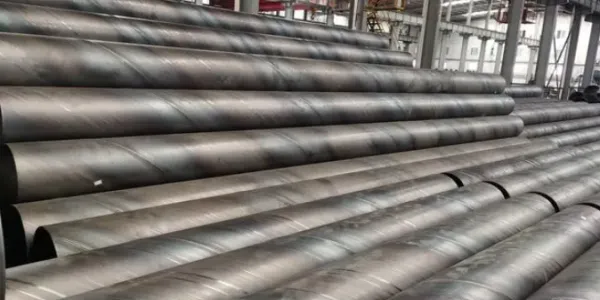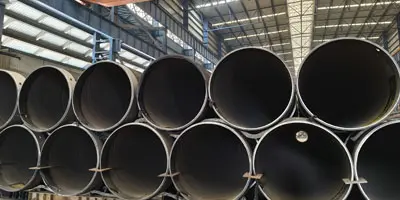In daily life, welded pipes can be seen everywhere and are widely used. Welded steel pipes are divided into straight seam steel pipes and SSAW steel pipes.During the welding process of SSAW steel pipes, the weld is easy to form a coarse columnar crystal structure with strong directionality. This structure is conducive to the segregation of harmful impurities and elements, promotes the formation of intercrystalline liquid film, and thus increases the sensitivity of thermal cracks. If the heating is uneven, it is easy to form a large tensile stress, which in turn promotes the generation of welding thermal cracks. Therefore, in the welding process of SSAW steel pipes, attention must be paid to the treatment of the weld to ensure the welding quality and the performance of the steel pipe.
Welding process of SSAW steel pipe
During the welding process, the strip steel is fed into the welding pipe unit, and through multiple rolling, the strip steel is gradually rolled up to form a round tube billet with an open space. Adjust the pressure of the kneading roller to control the welding space between 1mm and 3mm, and make the two ends of the weld flat. If the space is too large, the proximity effect is reduced, the eddy current heat is insufficient, and the intercrystalline bonding of the weld is poor, resulting in incomplete fusion or cracking; if the space is too small, the proximity effect increases, the welding heat is too large, which may cause burns, or the weld forms a deep pit after kneading and rolling, affecting the surface quality of the weld.

Storage and maintenance of SSAW steel pipes
Small and medium-sized steel products, wire rods, steel bars, medium-diameter steel pipes, steel wires, steel ropes, etc. can be stored in well-ventilated sheds, but they must be placed on mats. Small steel products, thin steel plates, steel strips, silicon steel plates, small-diameter or thin-walled steel pipes, various cold-rolled and cold-drawn steel products, and expensive and easily corrosive metal products can be stored in warehouses. The place or warehouse where SSAW steel pipe products are stored should be selected in a clean and well-drained place, away from factories and mines that produce harmful gases or dust. Weeds and all debris should be eradicated on site to keep the steel clean. Large steel products, rails, thick steel plates, large-diameter steel pipes, forgings, etc. should not be mixed and stacked with corrosive materials such as acids, alkalis, salts, cement, etc.
Transportation and loading and unloading of SSAW steel pipes
SSAW steel pipes will inevitably be damaged during loading and unloading. If the customer has high requirements for the appearance of SSAW steel pipes and needs to avoid damage such as collision, consider using protective devices between SSAW steel pipes, such as rubber, straw rope, fiber cloth, plastic, pipe caps, etc. The packaging materials should comply with relevant regulations to avoid waste and environmental pollution, and avoid loosening and damage during normal loading and unloading, transportation and storage. For SSAW steel pipes with special packaging requirements by the buyer, it should be indicated in the contract; if not indicated, the supplier can choose the packaging materials and packaging methods at its own discretion.
Protection measures for SSAW steel pipes
Thin-walled SSAW steel pipes can be protected by internal support or external frame protection measures, because thick-walled and thin SSAW steel pipes require additional support and external frame materials. If there are thread protectors at both ends of the SSAW steel pipe, they should be protected with thread protectors and lubricating oil or rust inhibitors should be applied to the threads. When both ends of the SSAW steel pipe are open, pipe mouth protectors can be added at both ends as required. When shipping SSAW steel pipes in containers, soft moisture-proof devices such as textile cloth and straw mats should be laid in the container, and protective brackets should be tied or welded on the outside of the SSAW steel pipe to prevent the steel pipe from scattering during transportation.
Inspection of structural strength and nodes of SSAW steel pipes
During the use of SSAW steel pipes, especially in the application of billboard steel structures, it is necessary to focus on checking the strength and rigidity of the structure, as well as components such as structural nodes, connection seams, bolts, and anchor bolts (anchor bolts). Specific inspection contents include the screws (including rivets) of the billboard steel structure panel, the weathering and corrosion degree of the material. For advertising pictures with membrane structures, it is also necessary to check their firmness, weathering and aging, and make necessary repairs and reinforcements. In addition, the binding of steel ropes should be firm and reliable, and lightning protection facilities and electrical safety insurance devices also need to be checked regularly to ensure safe and normal use.
Conclusion
SSAW steel pipes require strict measures to ensure their quality and performance during production, welding, transportation and storage. During welding, the gap of the weld and the pressure of the kneading roller must be controlled to avoid unfused, cracked or surface quality problems in the weld. During storage and transportation, appropriate protective measures should be taken to prevent damage to the steel pipe. Through these measures, the quality and service life of SSAW steel pipes can be effectively guaranteed, so that they can perform at their best in various applications. In actual operation, the process and measures should be continuously optimized according to the specific situation to cope with different environments and application requirements, so as to further improve the quality and reliability of SSAW steel pipes.






 English
English Español
Español بالعربية
بالعربية











 Phone :
Phone :  Whatsapp :
Whatsapp :  Email :
Email : 


